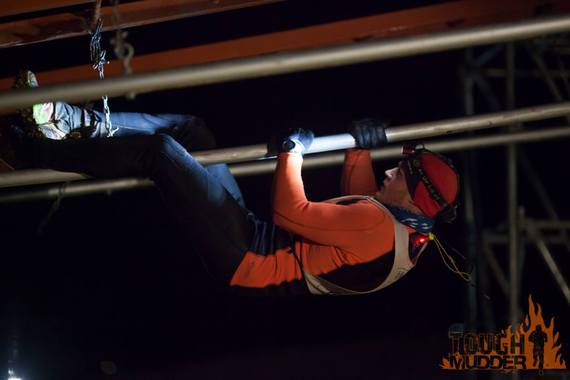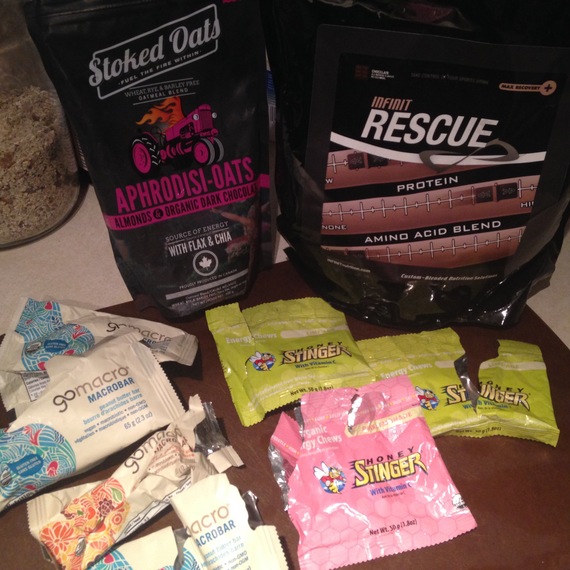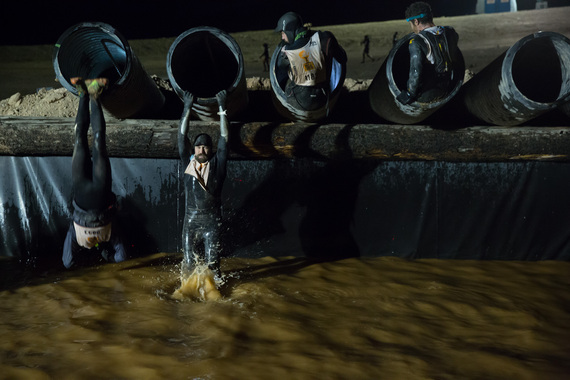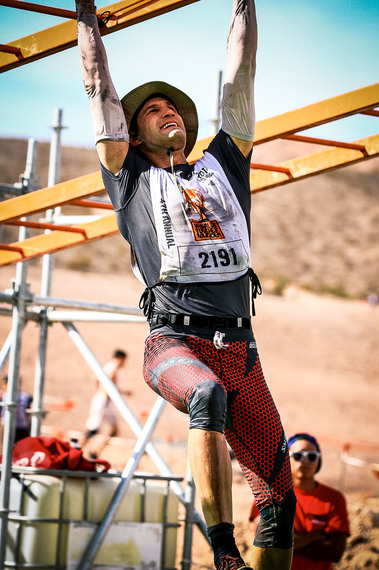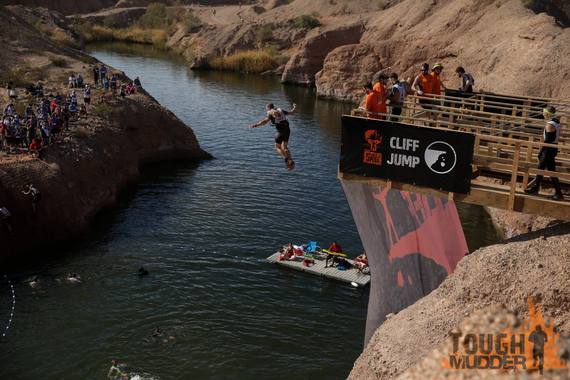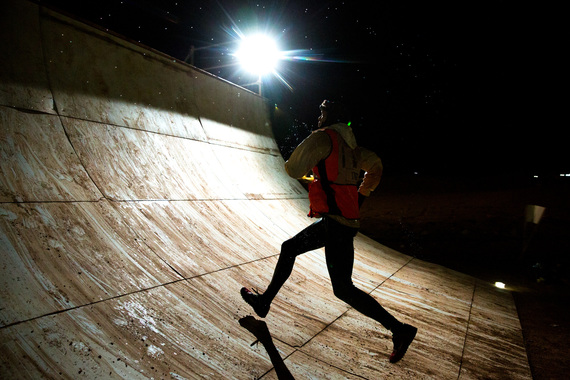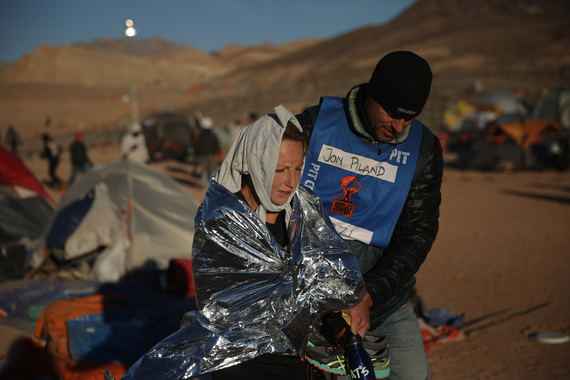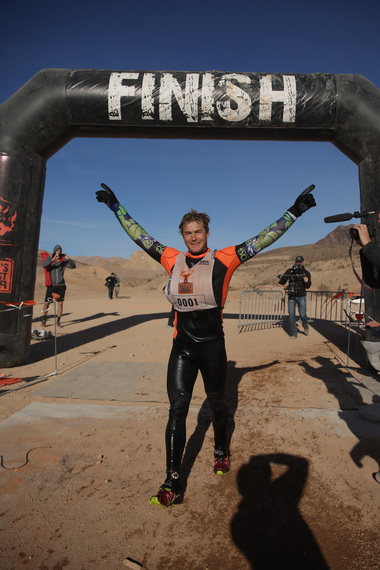The World's Toughest Mudder (WTM) is arguably the toughest obstacle course race (OCR) in North America, and possibly on the planet. Situated on the arid outskirts of Las Vegas, 2014 WTM competitors were challenged to complete as many laps around an obstacle heavy 5-mile loop as they could in 24 hours. Will Dean, the CEO of Tough Mudder, notes that in four years, they have reached over 2 million participants, and organized events in seven countries. As the OCR world continues to grow, so does competitor interest in these long format courses, which in turn is spawning new OCR races that combine the physicality of OCR with endurance needed for ultras. As the host of Boundless, a show where I travel the world competing in gruelling endurance challenges (airs on the Esquire Network), I can attest that this race ranks amongst the toughest endurance events on the planet.
With this year's race a few months away, and having raced the 2014 edition of WTM, I learned a lot about what success looks like -- and it's more than just the ability to do a ton of chin-ups. To help you reach the finish line, I've compiled ten key tips using my experiences, pro-tips from North America's Best OCR racers, and insider info from Tough Mudder staff on how to prepare for, and beat the World's Toughest Mudder in 2015:
1. Strength or Cardio: Most people think that OCR requires extreme strength -- and it does to a degree -- but not at the expense of endurance. For a race as long as the WTM, competitors need to have well conditioned lungs and toned muscles. Two time WTM champ Amelia Boone trains with a ratio of 60 percent endurance to 40 percent strength (including a heavy diet of CrossFit) while OCR pro Ryan Atkins puts his ratio at 70 percent endurance and 30 percent strength. Ultimately, each athlete needs to assess their strengths and weaknesses with the goal to maintain the strengths, while improving weaknesses. For me, my strength was the ultra running so I spent the months before the race incorporating upper body strengthening exercises to compliment my endurance.
2. Keep the Gas Tank Full: The 2014 WTM course was designed so that competitors ran laps of a 5-mile course, each time passing through the start/finish area and past their pit area. Since I was aiming for the podium, I opted not to carry food or drink while on course to save weight, but made sure that I stopped to eat and hydrate each lap as I passed through the athlete pit every hour. If you want to run without food or water, but eat while on course, Tough Mudder's chief of American Operations Lucas Barclay notes that the aid station sits 2.5 miles in and serves water and Met-Rx bars. Staying well fueled and properly hydrated, especially during the early hours of the race will help ensure success later in the event, especially during the colder Black-Ops (night time) hours.
3. Do your Research: I found it difficult to find information for this race online. Fortunately, I was able to get some beta from Amelia before the event but event still, I underestimated the hypothermia risk and went in missing one crucial piece of gear -- a wet suit. When the temperatures around Lake Las Vegas dropped towards the freezing point, I started to get very cold. This is an amphibious race, so competitors need to have a plan to stay warm in the dark. Since wind was also a major factor -- a wetsuit, a warm hat (neoprene), and a good shell was the way to survive Black-Ops. Without the wetsuit I couldn't insulate against the cold and I dropped out of the event 12 hours and 50 miles into, while in 5th place. It was a tough decision to stop but without a wetsuit, the prospect of 12 more hours made hypothermia a real consideration. Had I planned better, I would have brought a wetsuit. Preparing your clothing, food, sleep-system, and gear in advance is a huge advantage on race day.
4. Build your Strength Outside-In: OCR demands total body strength. Core conditioning is essential to staying strong and healthy during training and racing, but at the events, the toughest obstacles tend to be those that rely heavily on grip-strength, and lifting your bodyweight. With this in mind, it's important to build upper body strength from the outside-in, focusing on exercises that enhance your ability to lift or hang. Both Atkins and OCR ace Hunter McIntyre (winner of the team category at the 2014 WTM) are big advocates of grip strength, with Atkins advocating a mixture of rock climbing with traditional lifting, and McIntyre a fan of anything kettle bell. I found that a mix of chin-ups and rock climbing prepared me well for the variety of obstacles on the course. Remember this -- if the grip fails, it doesn't matter how strong the rest of your body is -- you're still on the ground or restarting the obstacle.
5. Train for the obstacles: Yes, it's common sense, but many athletes don't take the time to focus on understanding what obstacles they will have to conquer during the event. While it's great to be able to run fast and have strength, there are events that require technique or acclimation. The 2014 event saw a major water obstacle called "the cliff", which required athletes to jump 35 feet into the water. No technique required, but many athletes couldn't mentally deal with the height and chose to take the longer, slower opt-out. Other obstacles like monkey bars, and wall climbs are often easy early in the race, but get challenging as they become caked with mud, and as the body tires. Training on these to develop your own techniques to succeed will serve you well on race day. That said, there is really no way to prepare for the infamous electroshock therapy, which Race Course Designer Brady Archer tells me delivered 10,000 volts into my body on numerous unpleasant occasions.
6. Cardio is King: Strength may win shorter events, but in a 24 hour race, cardio is king. Boone's go-to cardio workout is stair climbing, but running is a close second for her and she cross-trains with rowing, swimming, and the ski-erg. Atkins comes from a competitive cycling background and still loves to ride, but also hits the trail for runs of all distance. Ever the outdoor enthusiast, Canadian biathlete, and 2014 Spartan Beast champion Claude Godbout uses nordic skiing, roller skiing, and running for her cardio workouts. When training for the WTM though, the main consideration is that you will be on your feet for up to 24 hours, so running and hiking workouts (of increasing length) should be a staple, as they condition the legs and feet.
7. Feet: Foot problems are common in long, wet races such as WTM. When I used to race the Eco-Challenge, part of my race preparations involved toughening my feet months out from the event. I would do this by hiking, running, and using ointments. On race-day, I would employe various strategies to prevent blisters, such as pre-taping blister prone spots, changing socks frequently, and changing shoes periodically. Because the WTM has you in the water several times per lap, your feet will stay wet, the skin will get soft, and blisters may become a reality, so prepare a foot strategy. Starting with the skin, I occasionally lube my feet with something like Hydropel. For socks, I've have had incredible success 100 percent merino wool socks (I use all-American brand Farm to Feet). I wear a neutral running shoe with ample tread and cushion (i.e. Merrell All Out Charge) and change them several times during the race (they fill with gravel and sand quickly). Finally, I recommend bringing a larger pair of shoes to wear later in the race as your feet will swell during the 24 hours, and the larger shoes will help prevent toe-nail loss.
8. Tent Strategy: Setting your tent up in the athlete village is all about location, location, location. If you are soloing, the closer you can get to the through-way, the easier it will be for you to stop and grab food or gear. With over 1000 athletes at the event, it can be challenging to find your tent in the sea of nylon, so make sure it's visible -- add a flag or something distinctive. Time spent looking for your tent is wasted time and stressful. Atkins arrived early in order to locate his tent right along the through-way, and created a well organized space for he, and his crew to operate during the event.
9: Get some Support: 24 hours is a long time to race, so having one or two friends or loved ones along support you is a huge benefit. While experienced races can still succeed solo, having support makes the athlete's life easier. Support can prepare food, prepare and assist with clothing changes, pack swaps, and keep you motivated. In addition, a good support team is beneficial when the night falls, as they can help keep an eye on you to monitor for hypothermia or sleep delirium and help keep you safe when your judgement lapses 50+ miles into the race. I came in without support but was fortunately adopted by Dirt in your Skirt founder Margaret Schlachter who made it easier for me to focus on racing and less on my pit-stops.
10. Tough Mind, Tough Mudder: In 2014, Ryan Atkins ran nearly 100 miles in 24 hours, or nearly 20 trips around the loop, while Boone completed 75 official miles and 15 laps. As if the course wasn't tough enough, racers had to fight unseasonably cold weather and brutal winds during the final 12 hours of the race. While physical ability is a major component of success, these races are won in the mind. Toughen your mind by competing in events outside of your comfort zone, or training days that push you in ways that you're not accustomed to. The more experience you have dealing with the cycle of highs and lows that will come in a race like this, the more likely it is that you will finish. Set reasonable goals, break the race into bite-sized pieces, give yourself permission to take breaks if you need them, and remember, if you can't run, then walk.

